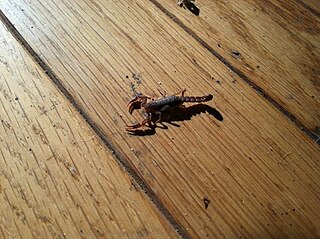
Scorpions are predatory arachnids of the order Scorpiones. They have eight legs, and are easily recognized by a pair of grasping pincers and a narrow, segmented tail, often carried in a characteristic forward curve over the back and always ending with a stinger. The evolutionary history of scorpions goes back 435 million years. They mainly live in deserts but have adapted to a wide range of environmental conditions, and can be found on all continents except Antarctica. There are over 2,500 described species, with 22 extant (living) families recognized to date. Their taxonomy is being revised to account for 21st-century genomic studies.

Paravaejovis spinigerus, commonly known as the stripe-tailed scorpion or the "devil" scorpion, is very common and widely distributed in Arizona and southwestern New Mexico. This species is one of larger members of the genus Paravaejovis, which also includes Paravaejovis confusus.

The Buthidae are the largest family of scorpions, containing about 80 genera and over 800 species as of mid-2008. Its members are known as, for example, fat-tailed scorpions and bark scorpions. A few very large genera are known, but a high number of species-poor or monotypic ones also exist. New taxa are being described at a rate of several to several dozen new species per year. They occur in the warmer parts of every major landmass on Earth, except on New Zealand. Together with four other families the Buthidae make up the superfamily Buthoidea. The family was established by Carl Ludwig Koch in 1837.

Centruroides is a genus of scorpions of the family Buthidae. Several North American species are known by the common vernacular name bark scorpion. Numerous species are extensively found throughout the southern United States, Mexico, Central America, the Antilles and northern South America. Some are known for their interesting patterning or large size ; most if not all fluoresce strongly under ultraviolet illumination, except after moulting. They contain several highly venomous species, and fatalities are known to occur. The venom of the Mexican scorpion Centruroides limpidus limpidus contains the neurotoxins Cll1 and Cll2.

Hoffmannius is a genus of scorpions in the family Vaejovidae. It comprises the following species:
The taxonomy of scorpions deals with the classification of this predatory arthropod into 13 extant families and about 1,400 described species and subspecies. In addition, 111 described taxa of extinct scorpions are known.

The Vaejovidae are a family of scorpions, comprising 17 genera, all except for Paruroctonus boreus(the northernmost scorpions in the world, present in Canada) found in Mexico and the Southern/Southwestern United States.
Uintascorpio is an extinct genus of scorpion in the family Buthidae and containing the single species Uintascorpio halandrasorum. The species is known only from the Middle Eocene Parachute Member, part of the Green River Formation, in the Piceance Creek Basin, Garfield County, northwestern Colorado, USA.
Typhlochactas mitchelli is a species of scorpion of the family Typhlochactidae. It is endemic to the state of Oaxaca, Mexico. This species is of the eyeless cave-dwelling genus Typhlochactas.

Vaejovis is a genus of scorpions.
Brachistosternus is a scorpion genus in the Bothriuridae family. B. ehrenbergii is the most cited species in the genus. Brachistosternus is composed of 16 species grouped into three subgenera spread out over Argentina, Bolivia, Brazil, Chile, Colombia, Ecuador, Paraguay, and Peru.
Smeringurus is a small genus of scorpions native to Mexico and the southwestern United States within the family Vaejovidae. It is closely related to the genus Paruroctonus, of which it was formerly considered a subgenus.

Paruroctonus is a genus of scorpions in the family Vaejovidae. There are about 8 described species in Paruroctonus.

The Iuridae are a family of scorpions in the order Scorpiones. Six genera and at least 20 described species are placed in the Iuridae.
Calchas is a genus of scorpions in the family Iuridae. At least four species in Calchas are described.
Kovarikia, is a genus of scorpion belonging to the family Scorpionidae. All described species are restricted to humid rocky microhabitats of southern California. Three species identified.

Paravaejovis is a genus of scorpion in the family Vaejovidae. There are about 11 described species in Paravaejovis.
Uroctonus is a genus of forest scorpions in the family Vaejovidae. There are at least four described species in Uroctonus.
Maaykuyak is a genus of scorpions in the family Vaejovidae, native to Mexico and Texas.

Diplocentrus is a genus of toothed scorpions in the family Diplocentridae. There are more than 60 described species in Diplocentrus, found mainly in Central American, Mexico, and the southwest United States.








